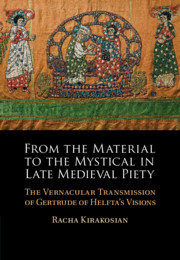 From the Material to the Mystical in Late Medieval Piety
From the Material to the Mystical in Late Medieval Piety Published online by Cambridge University Press: 01 September 2021
The image of ‘writing from the heart’ – the subject of this chapter – is central to the texts produced by the Helfta nuns, and is prominent in both Mechthild of Hackeborn’s Liber specialis gratiae and Gertrude of Helfta’s Legatus divinae pietatis. Instances of the Sacred Heart need to be seen in a wider context, including scholastic texts as well as mystical traditions, which consider processes of wounding and their affinity with writing. In this sense, it is important to look at where the Legatus may have found inspiration for the motif of the heart, exploring resemblances to Victorine ideas, and texts by writers such as Bernard of Clairvaux, Alan of Lille, and Mechthild of Magdeburg. The influence of Mechthild of Magdeburg’s Flowing Light of the Godhead, which was composed before the Liber and the Legatus, has gone largely unnoticed. The following investigation addresses this issue and shows that ideas central to ‘the scriptorial heart’ – in Helfta, related to Christ’s Passion – are to be found in Mechthild’s Flowing Light. Indeed, ‘writing from the heart’ is more of a compositional principle for the Helfta nuns than a mere literary trope, as I show in this chapter.1 Imaginary texts in visions are intertwined with imagery of writing connected to the heart; in this way, repeated references to the productive heart, on the basis of the medieval understanding of the heart as seat of the soul, illustrate how the mystical union is communicated in bodily terms.
To save this book to your Kindle, first ensure [email protected] is added to your Approved Personal Document E-mail List under your Personal Document Settings on the Manage Your Content and Devices page of your Amazon account. Then enter the ‘name’ part of your Kindle email address below. Find out more about saving to your Kindle.
Note you can select to save to either the @free.kindle.com or @kindle.com variations. ‘@free.kindle.com’ emails are free but can only be saved to your device when it is connected to wi-fi. ‘@kindle.com’ emails can be delivered even when you are not connected to wi-fi, but note that service fees apply.
Find out more about the Kindle Personal Document Service.
To save content items to your account, please confirm that you agree to abide by our usage policies. If this is the first time you use this feature, you will be asked to authorise Cambridge Core to connect with your account. Find out more about saving content to Dropbox.
To save content items to your account, please confirm that you agree to abide by our usage policies. If this is the first time you use this feature, you will be asked to authorise Cambridge Core to connect with your account. Find out more about saving content to Google Drive.